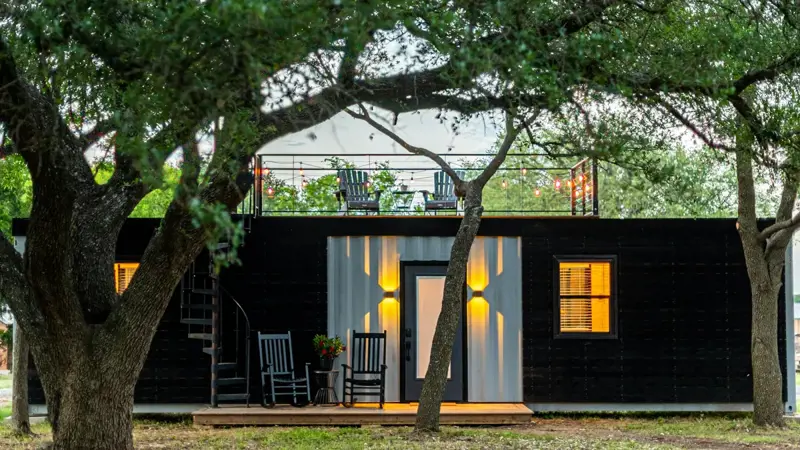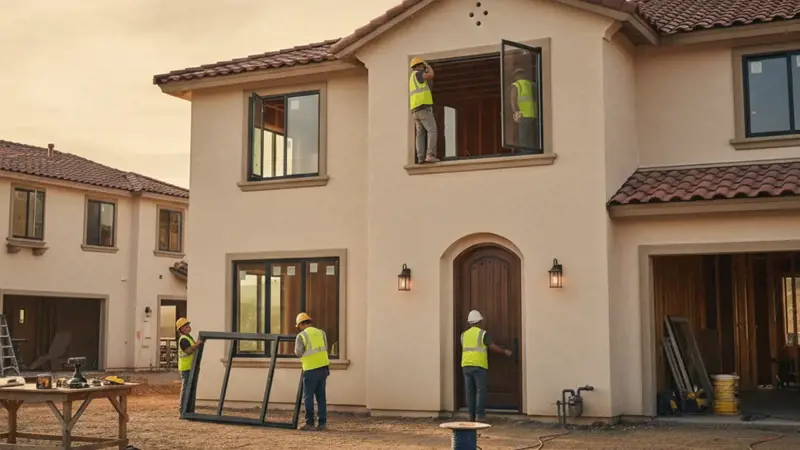Building a container home in the U.S. in 2025 typically costs between $15,000 and $175,000, depending on several factors such as size, design complexity, location, and finishing quality. This wide cost range makes container homes one of the most affordable and flexible alternatives to traditional housing, while still offering durability and customization.
Container homes are gaining popularity for their eco-friendliness, modular design, and relatively quick construction times. However, understanding the breakdown of costs and the variables involved is crucial before starting your project.
Quick Answer: Typical Cost Breakdown
- Small DIY builds: $15,000 – $35,000
- Mid-range professional builds: $50,000 – $100,000
- Luxury custom builds: $120,000 – $175,000
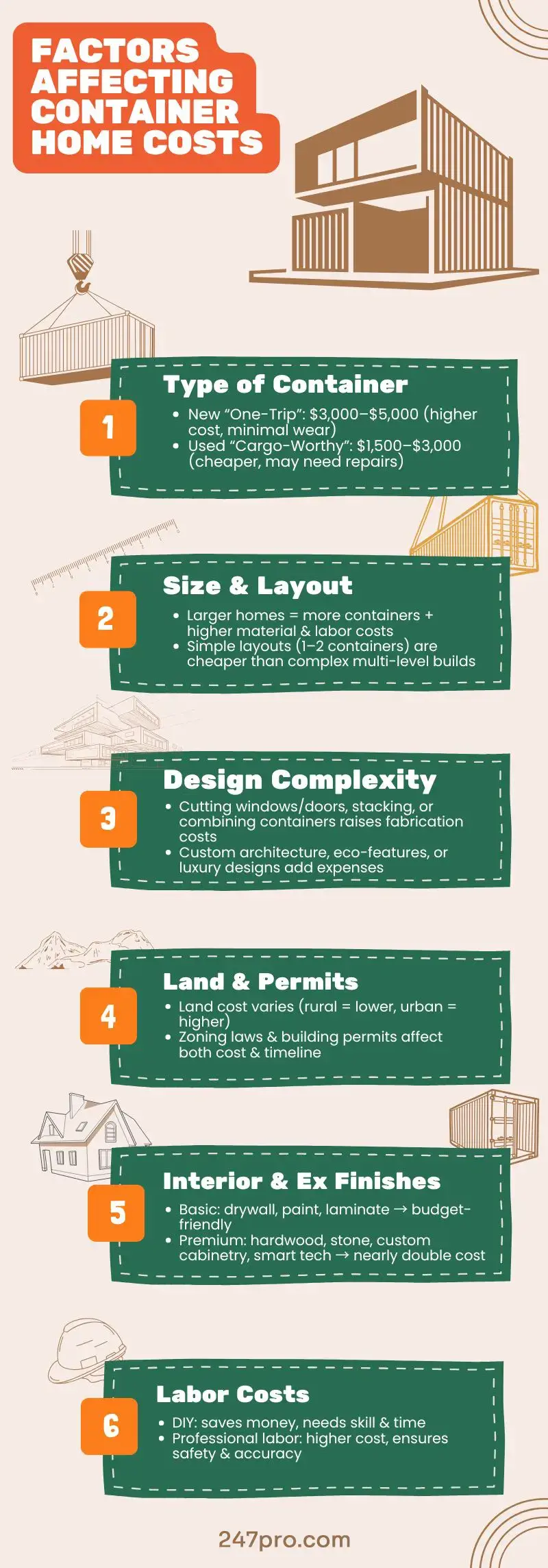
Factors That Affect the Cost of Building a Container Home:
The total cost to build a container home depends on many variables, including:
- Type of Container New “one-trip” containers are freshly manufactured or used only once for shipping. They cost more, usually $3,000 to $5,000 per container.
- Used “cargo-worthy” containers are cheaper, ranging from $1,500 to $3,000, but may require more repairs or cleaning.
- Size & Layout Larger homes require more containers, increasing costs for materials and labor.
- Simple layouts (single container or stacked containers) cost less than complex multi-container configurations with multiple levels and cutouts.
- Design Complexity Structural modifications like cutting windows, doors, or combining containers increase fabrication costs.
- Advanced architectural designs, green building elements, and custom features add to expenses.
- Land & Permits Land prices vary widely by state and region, from affordable rural areas to expensive urban locations.
- Building permits and zoning laws also impact costs and timeline.
- Interior & Exterior Finishes Basic finishes like drywall, paint, and laminate flooring keep costs low.
- High-end finishes such as hardwood floors, custom cabinetry, stone countertops, and smart home technology can nearly double the budget.
- Labor Costs DIY construction can reduce costs but requires time and skill.
- Hiring professionals (electricians, plumbers, welders) increases accuracy and safety but adds to labor expenses.
Tip: Use online building price estimators tailored to your state and design plans to get precise cost projections.
Average Cost to Build a Container Overview (2025)
The average cost to build a container home can vary depending on size, design, and location. Below is an overview of typical price ranges that homeowners can expect when planning a container home project in 2025:

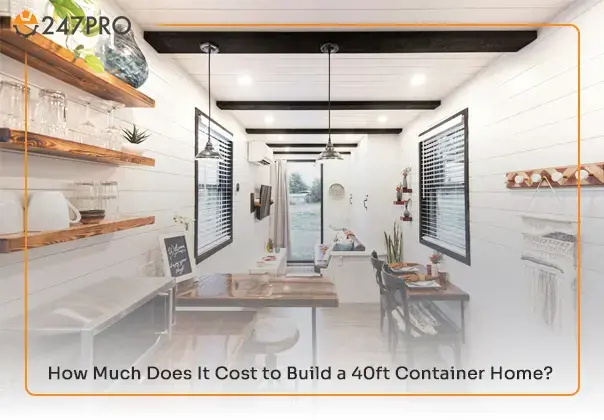
How Much Does It Cost to Build a 40ft Container Home?
A 40ft container home, approximately 320 square feet, is one of the most common builds. The average cost ranges between $35,000 and $80,000, including:
- Container purchase
- Site preparation & foundation
- Insulation & waterproofing
- Doors, windows, and utilities installation (plumbing, electrical)
- Basic interior finishes (drywall, paint, flooring)
If you opt for multiple 40ft containers combined for a larger home, costs will scale accordingly.
How Much to Build a Small Container Home?
A small container home, usually a 20ft container, costs roughly $15,000 to $35,000. This size is perfect for tiny home enthusiasts, vacation cabins, or studios. Costs are lower because of:
- Reduced material needs
- Simpler labor requirements
- Minimal design complexity
These costs are comparable to many tiny home projects but with the added benefit of a strong steel shell.
What Is the Best State to Build a Container Home?
The cost of building a container home varies greatly depending on the state because of differences in land prices, climate, and local regulations. Here's a general cost comparison:

Climate Considerations: Hot or cold climates require additional insulation and HVAC (heating, ventilation, air conditioning) costs, which can increase the budget by 10-20%. Temperate climates generally have lower building costs due to less extreme weather demands.
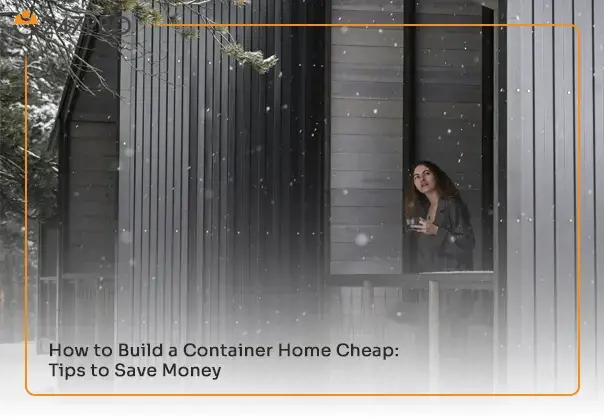
How to Build a Container Home Cheap: Tips to Save Money
If you want to reduce your building costs, consider the following:
- Buy used containers: Sourcing second-hand containers in good condition can save thousands. Inspect carefully for rust or structural damage.
- DIY where possible: Taking on tasks like painting, interior finishes, or landscaping reduces labor costs significantly.
- Keep designs simple: Minimalist layouts with fewer structural modifications are more budget-friendly.
- Source materials locally: Reduces transportation and delivery fees.
- Hire smart: Use a builder recruitment agency or get multiple contractor bids to ensure competitive pricing and quality work.
Cost Comparison: Container Homes, Traditional Houses & Tiny Homes
If you're debating between a container home and other types of construction, here’s how the costs generally compare, including the cost to build a metal building, the cost to build a tiny home, and the cost to build a traditional home.
Container homes tend to be cheaper per square foot while still offering customization options and eco-friendly benefits.
Advantages and Disadvantages of Container Homes
Advantages:
- Eco-friendly: Reuses shipping containers and reduces waste.
- Quick construction: Modular design allows faster build times.
- Durability: Steel structure resists harsh weather and pests.
Disadvantages:
- Limited space: Requires careful design for comfort in smaller footprints.
- Permit challenges: Some municipalities lack clear regulations for container homes.
- Insulation needs: Steel containers require quality insulation to manage temperature.
- Resale value: Can be uncertain compared to traditional homes.
Key Steps to Building Your Container Home
- Research local zoning laws and building codes.
- Choose your container type and size.
- Secure land and permits.
- Design your layout or hire an architect.
- Prepare the site and foundation.
- Modify containers (cut windows/doors, paint).
- Install utilities (plumbing, electrical).
- Finish interior and exterior surfaces.
- Final inspections and move-in.
Frequently Asked Questions (FAQ)
1. How long does a container home last?
With proper maintenance (anti-rust painting, correct insulation), a container home can last more than 30 to 40 years.
2. Can a container home be expanded later?
Yes. One of the biggest advantages of container homes is their modular design. You can add more containers and expand your living space over time.
3. Do banks offer mortgages for container homes?
Some banks and financial institutions provide loans for container homes, especially if the home is permanently fixed to land. However, not all banks currently accept this type of financing.
4. Are container homes suitable for permanent living or just for vacation use?
Both! Many people choose container homes as their permanent residence, while others use them as vacation cabins, rental properties, or even home offices.
5. Can modern amenities like a luxury kitchen or smart home system be installed?
Absolutely! Container homes can be equipped with all modern features, just like traditional houses, including luxury kitchens, advanced bathrooms, and smart home technology.
6. How secure is a container home against theft or accidents?
Since containers are made of steel, they are highly durable. With proper doors and windows installed, their security is comparable to a conventional home.
7. Can a container home be insured?
Yes. Many insurance companies provide coverage for container homes, but it often depends on whether the home is permanently fixed to land or remains movable.
Key Takeaways for Budgeting Your Container Home
Building a container home in 2025 offers an affordable, flexible, and eco-friendly housing solution. By understanding cost ranges upfront, choosing the right location, and applying cost-saving tips, you can efficiently plan your project and avoid unexpected expenses.
Building a container home doesn’t have to be complicated or costly. Let our experts simplify the process for you — from sourcing materials to managing construction.
Visit our Pro-finder Service and start building your dream container home with ease and confidence.
